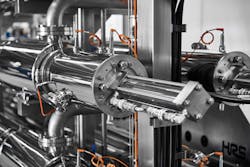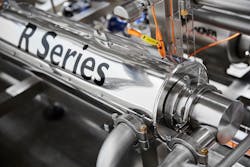Finding the right recipe for heating food products
Heat is fundamental to the food and beverage processing industry. From cooking and drying to other treatments such as pasteurization, heat is widely used in all but the most basic food and beverate processing situations — in sectors as varied as dairy, fruit and vegetable processing, meat, prepared foods, brewing and dietary supplements.
As you would expect, this demand for heating (and cooling) food and drink requires a large amount of energy. According to estimates1 roughly 10% of total U.S. energy use comes from the food system — that is a massive 10.11 quadrillion Btu, of which 16% (1.6 quadrillion Btu) comes from food processing. However, that figure is less that the 2.75 quadrillion Btu estimated by the USDA Economic Research Service in 20022, so things are moving in the right direction.
While there are many uses for energy in food and beverage processing, this figure includes equipment such as ovens, boilers and space heaters, as well as processes such as drying, pasteurization, sterilization and concentration.
Minimizing environmental impact, maximizing profit
Bioenergy is one way that some food and beverage processors have reduced their environmental impact and made best use of certain processing by-products and biomass wastes, with technologies including anaerobic digestion and biomass combustion becoming more popular in recent years, alongside other forms of renewable energy. While this has helped to reduce the food and beverage sector’s environmental footprint, the importance of maximizing process efficiency — and thermal efficiencies in particular — is sometimes overlooked. Not only will improving efficiency provide environmental benefits such as less energy use and less waste, but it will also generate greater economic returns for the business.
Recapturing and reusing heat (such as surplus heat from cooling operations or spare boiler capacity) can be an effective way of increasing capacity or adding a new production process without the need for major new energy infrastructure. Depending on the application, HRS Heat Exchangers’ equipment, for example, has been shown to recover as much as 50% of previously wasted heat, which can then be used for water, space or process heating, waste treatment or other thermal applications.
Influencing factors
Heat exchangers are an effective and efficient solution for many food and beverage processes, such as pasteurization and concentration, and are more likely to enable heat regeneration than other systems, such as ovens or retorts. The choice of heat exchanger will depend on many different factors, such as the nature of the process to be carried out (pasteurization, sterilization, dehydration, etc.), the viscosity of the food or drink being processed, and whether it contains particles or pieces.
Newtonian and non-Newtonian fluids will also behave differently under different temperature and pressure regimes, and this will affect the handling required during processing. For example, if subjected to too much pressure, certain sauces may shear, resulting in them failing to meet the end specification — such as pizza sauce not staying on the pizza. Another challenge is presented by some fat-free products which become more or less viscous with temperature, and so may be more fluid on the cooling side of the heat exchanger than the heating side.
Benefits of corrugation
These issues can be overcome by careful system design, and, in particular, by specifying the correct type of heat exchanger. Corrugated tube heat exchangers, like the HRS MI and MR Series, are available in various configurations, so that delicate materials such as cream can be processed without damage. The corrugated design also minimizes fouling, which increases the thermal efficiency and prolongs operational periods between cleaning. In addition, corrugated tube heat exchangers have a lower pumping requirement than smooth tubular heat exchangers due to their compact nature, which results in a lower pressure drop. This helps increase operational life while reducing maintenance costs compared with other types of heat exchanger.
Reducing waste
For some products, such as curd production in the dairy sector, increased turbulence can be beneficial. Alternatively, where low pressures are required, scraped surface heat exchangers, like the HRS Unicus Series, which features a reciprocal movement, keep things flowing smoothly while handling the product gently (which is one way to overcome the pizza sauce example cited above). Using the right type of heat exchanger can also help to reduce product losses caused by materials remaining in equipment at batch changeovers or when cleaning is required. Some scraped surface heat exchangers, such as the HRS R Series (with a rotating scraper action), can be configured to run in reverse, effectively removing product from the heat exchanger without damaging it or affecting its quality.
When dealing with any food and beverage processing machinery, it is critical to check for compliance with the necessary legislation. Ultimately, though, you need to ensure that the equipment you choose will perform as required. And, as with any capital expenditure, it is important to compare not just the initial capital costs, but also the operational and maintenance costs across the life of the machinery. All heat exchangers are not alike, but these differences mean that there is undoubtedly a heat exchanger solution that fits your food and beverage processing needs.
Cameron Creech is general manager, at HRS Heat Exchangers. Located in Atlanta, Georgia, HRS Heat Exchangers is part of the HRS Group which operates at the forefront of thermal technology, offering innovative heat transfer solutions worldwide across a diverse range of industries.
About the Author
Cameron Creech
General Manager, HRS Heat Exchangers
Cameron Creech is general manager at HRS Heat Exchangers. Located in Atlanta, Georgia, HRS Heat Exchangers is part of the HRS Group which operates at the forefront of thermal technology, offering innovative heat transfer solutions worldwide across a diverse range of industries. With 40 years’ experience in the food and beverage sectors, specializing in the design and manufacture of an extensive range of turnkey systems and components, incorporating our corrugated tubular, and scraped surface heat exchanger technology, HRS units are compliant with global design and industry standards.


